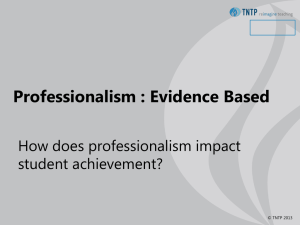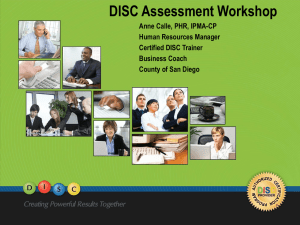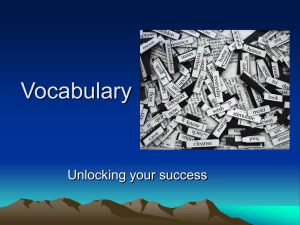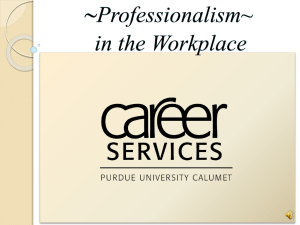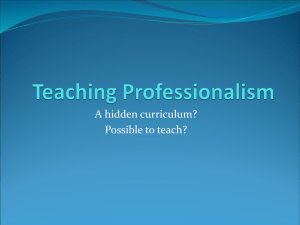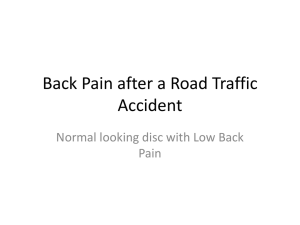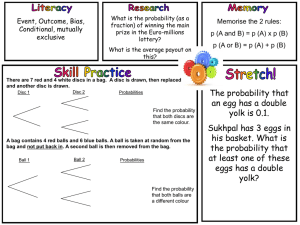Customer Service
advertisement
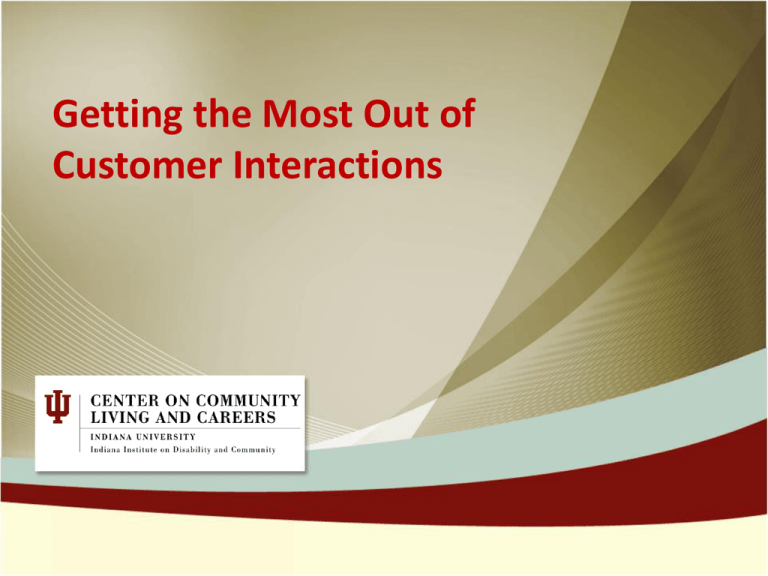
Getting the Most Out of Customer Interactions Welcome • Welcome! • Facilitator: Tracy Laycock Supplemental Resources • Center on Community Living and Careers (CCLC) Web site • Leadership Academy Courses in OnCourse Professionalism and Good Business Sense Professionalism – Definition • Business Dictionary.com: • Meticulous adherence to undeviating courtesy, honesty, and responsibility in one's dealings with customers and associates, plus a level of excellence that goes over and above the commercial considerations and legal requirements. Importance of Professionalism • • • • • Ensures good performance by all Ensures good team spirit Keeps employees motivated Ensures justice to everyone’s efforts Maintains the right amount of communication Professionalism Tips • • • • • • • • Make excellence your goal Get your basics right Take your job seriously Switch off personal problems Focus on your work Be willing to learn Be a team player Enjoy what you do Professionalism vs. Customer Service • Are professionalism and good customer service the same or different? Barriers to Good Customer Service • Human Barriers • Environmental Barriers First Impressions First Impressions • The first 30 seconds • No second chances • Some tips to remember – – – – Focus on the other person’s needs Demonstrate good listening skills Check your appearance Remember names Elements of Communication • Body language • Voice tone • Words Body Language Voice Tone • Three types: – Negative – Neutral – Positive • Other voice tone techniques: – Meet the pace of the consumer – Gain attention by changing your volume – Use emphasis and inflection to convey interest and concern Words • Use positive phrasing to show consumers that you care: – Acknowledging phrases – Affirming phrases – Assuring phrases Dealing with Difficult People Some Truths About Difficult People DISC Behavior Model • Based on psychological theory developed in the 1920s • Describes a person’s natural reaction mode or behavioral style in different situations • Provides a tool to help understand one’s own and other’s behavior DISC Behavior Model D – Dominance I – Influence Emphasis: Shaping the environment by overcoming opposition and challenges Emphasis: Shaping the environment by influencing or persuading others S – Steadiness C – Conscientiousness Emphasis: Cooperating with others within existing circumstances to carry out the task Emphasis: Working conscientiously within existing circumstances to ensure quality and accuracy DISC Behavior Model • D – Style – – – – – – – Decisive, tough Strong-willed Competitive, demanding Independent, self-centered Under pressure: shows lack of concern Fear: loss of control Relating to D Behavior: be direct, straightforward, and open to their needs for results DISC Behavior Model • I – Style – – – – – – – Sociable Talkative, open Enthusiastic, energetic Persuasive Under pressure: disorganized Fear: social rejection Relating to I behavior: be friendly, emotionally honest, and recognize contributions DISC Behavior Model • S – Style – – – – – – – Calm, steady Careful, patient Family-oriented Good listener, modest, trustworthy Under pressure: too willing Fear: loss of stability Relating to S behavior: be relaxed, agreeable, cooperative, and show appreciation DISC Behavior Model • C – Style – – – – – – – Precise Follows rules Logical, careful Formal, disciplined Under pressure: overly critical Fear: criticism of work Relating to C behavior: minimize socializing, give details, and value accuracy Emotional Hot Buttons • Do Any of These Behaviors Bother You? “You never/always….” Know-it-all attitudes “Shut up!” Bad grammar “What you should do is….” Whining “If I were you….” Pushy individuals “I don’t know.” Others? Dealing with Difficult People • Tips for dealing with the occasionally difficult person 1. 2. 3. 4. 5. Separate personality from behavior. Don’t take it personally. Try to see his or her perspective. Be patient. Take a break and try again later. Conclusion • Thank you for your time. • We look forward to your participation in future webinars. • Remember to access the CCLC Web site or the Leadership Academy Course in OnCourse to find resources and a link to a survey about this session.
